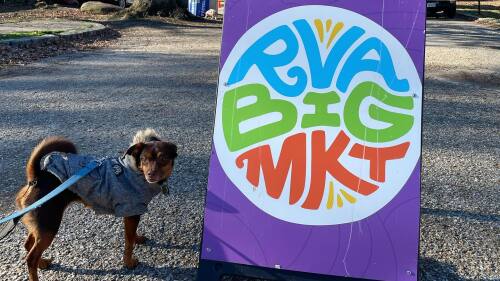April 4 marks the anniversary of President Abraham Lincoln’s 1865 visit to Richmond — two days after Confederate forces evacuated the city. Less than two weeks later, he was assassinated.
Lincoln came to the capital of the Confederacy in the war’s final days, before Lee’s surrender at Appomattox on April 9, 1865. Jefferson Davis had fled Richmond for Danville on April 2.
Before Lincoln arrived, the newspaper The Richmond Whig documented the frenzied Confederate evacuation. People scrambled to leave the city, rushed storehouses, and fled the fires that were spreading downtown.

A lithograph produced by Currier & Ives depicts the fall of Richmond in 1865.
Photo via Library of Congress
“A whirlwind sweeping through dead leaves in autumn scattered them no more wildly than official documents, pamphlets, &c., were scattered on Monday evening,” the Whig wrote. “Confederate bonds, Confederate notes, bank checks, bills, flecked and whitened the streets in every direction — all so worthless that the boys would not pick them up.”
The visual of the “paper tornado” would remain throughout Lincoln’s visit to the Virginia Capitol, where discarded money and government papers littered the halls.
Lincoln arrived in Richmond by rowboat, stepping onto land at 17th Street near Dock. The first people to greet him were a group of Black men working to repair a bridge and a reporter from Boston. News of the president’s arrival quickly spread through the city, and he was soon swarmed by crowds as he and his son Tad made their way towards the former White House of the Confederacy.

A wood engraving depicts Lincoln’s greeting from the crowds.
Photo via Library of Congress
Although he lacked the security that might have been expected, Lincoln made his way up 17th as onlookers cheered him. Admiral David D. Porter and a group of sailors accompanied the president and his son.
“The President was on foot, and walked rapidly, towering above the crowd,” the Whig reported. "[Lincoln] was dressed in a long black overcoat, high silk hat, and black pants, giving to his form a very commanding appearance.”
Many apocryphal tales have been told about how the president may have interacted with the crowd — rumors spread that people named him a messiah and that he joined a group in prayer — but historians agree the scene was enthusiastic.
“Such wild, indescribable ecstatic joy I never witnessed,” the Boston Journal’s Charles Coffin wrote.
The procession was slow due to the crowd, the heat, and the hill — if you’ve ever heaved your way north from Shockoe towards Broad Street and had to catch your breath, you have something in common with President Lincoln. Eventually, the party turned down Clay Street and arrived at its destination.

A wood engraving shows onlookers at the White House of Confederacy as Lincoln approaches.
Photo via Library of Congress
After a meeting with the occupying Union officials at the former White House of the Confederacy, Lincoln set off in a carriage for a tour of the city. He went by the Capitol and Libby Prison before stopping at Rocketts Landing to spend the night on the USS Malvern.
The next day, Lincoln left Richmond. He returned to Washington days later. On April 14, 1865, he was shot at Ford’s Theatre and died the next morning.
The National Park Service brought renewed attention to Lincoln’s visit to Richmond in 2003 when it unveiled a commemorative statue at Tredegar Iron Works. The life-size sculpture depicts Lincoln seated with Tad. It’s now on display at The Valentine, steps from the White House of the Confederacy.











